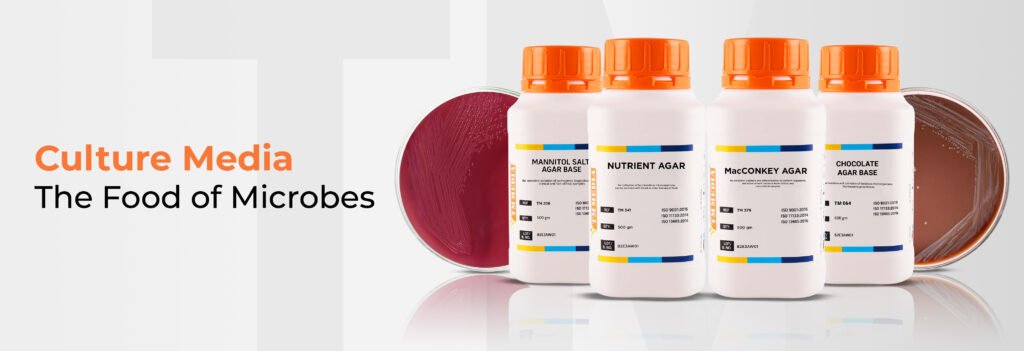

Every living organism needs food for growth and to multiply, and today we’ll talk about the food of microbes, technically called Culture Media.
It is a carefully formulated mixture of various Biological Media Bases which provide plants the nutritional compounds such as nitrogen, amino acids, carbohydrates, vitamins, minerals, and many more.
Depending on the microbial species and experiment objectives, Culture Media can vary in composition, consistency, and function.
It can be general, selective, differential, or enriched based on chemical composition.
General Media are also known as basal media. They are designed to support the growth of a wide range of microorganisms, specifically non-fastidious microorganisms. This media does not contain any growth enhancers or inhibitors. One of the best examples of General Media is Nutrient Agar.
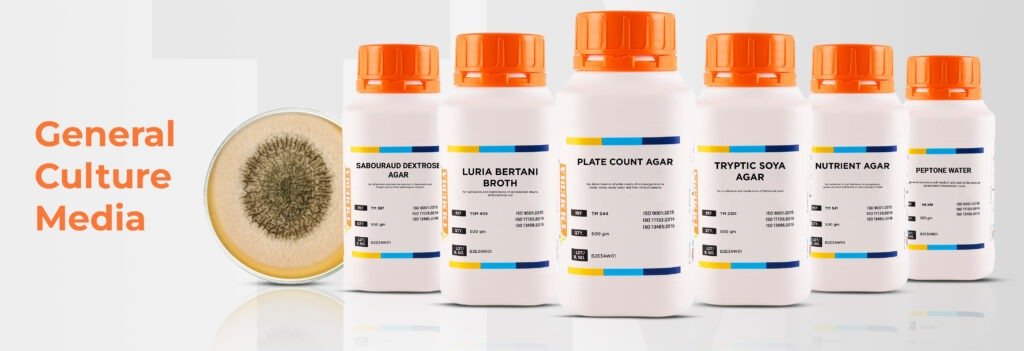
Nutrient Agar supports the growth of a wide range of bacteria and fungi, which makes it favourable in industrial as well as academic settings.
A few other examples of General Media are Nutrient Agar, Tryptic Soya Agar, Peptone Water, Plate Count Agar, Sabouraud Dextrose Agar, Luria Bertani (LB) Agar/Broth.
Selective Media are used to grow specific types of microorganisms from mixed cultures. These media contain specific substances that inhibit the growth of some microorganisms while allowing the growth of others. One of the best examples of Selective Media is MacConkey Agar.
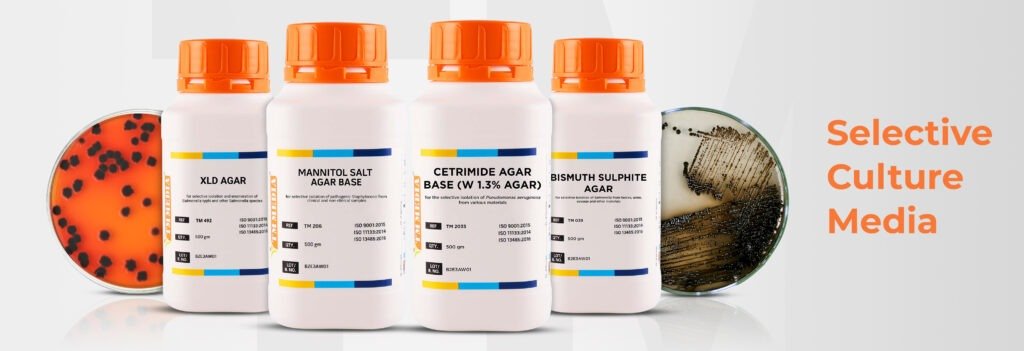
MacConkey Agar supports the growth of Gram-negative bacteria by inhibiting the growth of Gram-positive bacteria.
A few other examples of Selective Media are
| Mannitol Salt Agar (MSA) – for Staphylococci |
| Xylose Lysine Deoxycholate (XLD) Agar – for Salmonella and Shigella |
| Bismuth Sulphite Agar – for Salmonella typhi |
| Cetrimide Agar – for Pseudomonas aeruginosa |
Differential Media are used to distinguish different types of microorganisms based on their characteristics. Generally, these media contain indicators that indicate the changes of medium that are caused by microorganisms. One of the best examples of Differential Culture Media is Eosin Methylene Blue Agar.
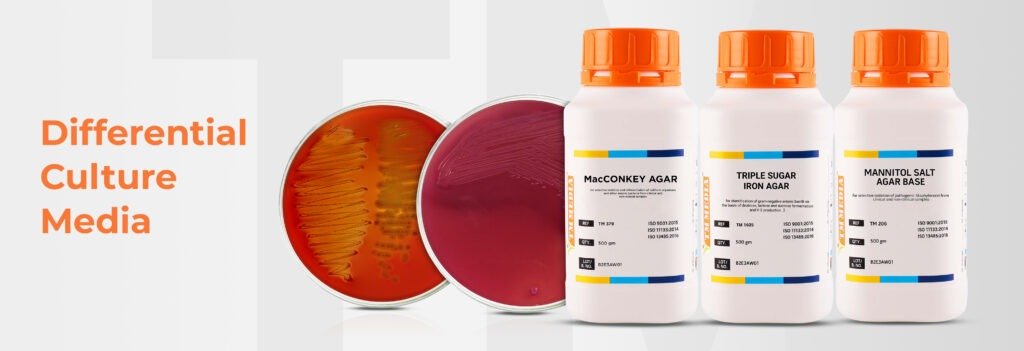
Eosin Methylene Blue Agar is used to differentiate lactose fermenters from non-fermenters by colour changes.
A few other examples of Differential Media are
| MacConkey Agar – Differentiates lactose fermenters and non-fermenters |
| Sheep Blood Agar – Differentiates organisms by haemolysis patterns |
| Triple Sugar Iron Agar – Differentiates based on sugar fermentation and H₂S production |
| Mannitol Salt Agar – Differential for Staphylococcus aureus |
Knowledge takeaway: Some Culture Media behave as both Selective Media and Differential Media
Enriched Media are supplemented with highly nutritious materials like blood, serum, or special Media Supplements that support the growth of fastidious microorganisms. One of the best examples of Enriched Media is Sheep Blood Agar.
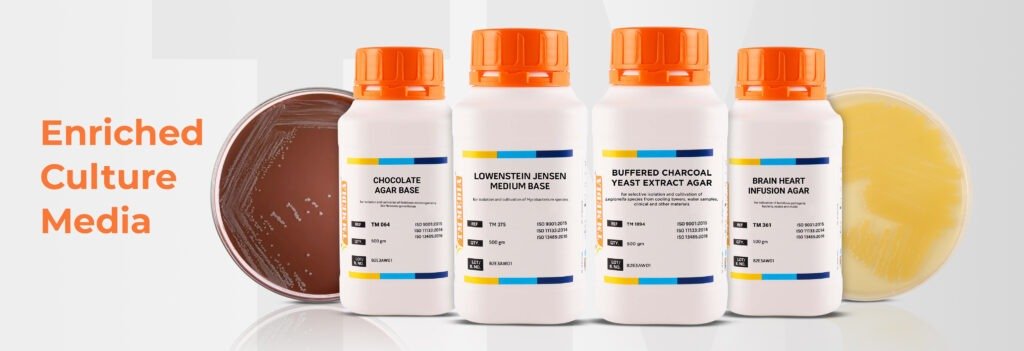
The Sheep Blood Agar contains 5-10% Sheep Blood as a highly nutritious material. It is used to distinguish organisms based on their patterns of haemolysis; organisms show alpha, beta, and gamma haemolysis based on their characteristics.
A few other examples of Enriched Media are Chocolate Agar is a heated version of Sheep blood agar for Haemophilus and Neisseria species.
Löwenstein-Jensen Medium is an enriched medium for Mycobacterium tuberculosis.
Buffered Charcoal Yeast Extract (BCYE) Agar is used to isolate Legionella species.
Brain Heart Infusion (BHI) Agar/Broth is used to grow fastidious bacteria, fungi, and yeasts.
Culture Media can be solid, liquid, or semi-solid on the basis of consistency.
Solid Media are used to grow a wide range of microorganisms. They are generally preferred during pure isolation from a mixed flora. Solid Culture are prepared by adding Agar into the composition.
Agar is a gelling agent that melts at approximately 85°C and solidifies at room temperature. It is inert and non-nutritive. It forms a firm and stable gel that does not get degraded by microbes. On solidification it remains clear, hence it doesn’t hamper colony observations.
Solid Agar can be used in Plates, Bottles, and Tubes.
In technical terminology, Liquid Media are generally referred to as Broth. These media do not contain any solidification agent like Agar. They are generally preferred to grow large volumes of microorganisms, for example, in industrial settings.
Liquid Media are ideal for fermentation, biochemical testing, stock culture maintenance, probiotic production, agri-inputs production and more similar applications.
As the name suggests, Semi-Solid Media are a version of Solid Media but with a lower concentration of Agar. They are used for the isolation of motile bacteria such as Vibrio cholerae.
Bonus part
There are also Chromogenic Culture Media which contain a chromogen in their composition. It allow isolation, differentiation and identification of more than one organism at once. The chromogen reacts differently with every species, and hence every microorganism shows a specific colour colony.
For example, the Chromogenic Candida Agar offered by TM Media makes Candida species isolation easy from Candida mixed flora samples.
| Specie | Colour |
| Candida albicans | Light green |
| Candida glabrata | Cream to white |
| Candida tropicalis | Blue to purple |
| Candida krusei | Purple, fuzzy |
Too many media, too many types, but one common thing is quality ingredients make a nutritious Culture Media which supports a luxuriant growth of microorganisms for further study. Therefore, Culture Media preparation is one of the crucial steps of microbiology testing. This process is important as well as time-consuming, and to save time and resources and to minimize the risk of errors, TM Media is offering Dehydrated Culture Media. At TM Media we have over 2500 Dehydrated Culture Media to fulfil the needs of every microorganism for every application.

Join us as we take part in the Thailand Lab International Exhibition 2025! Explore the business opportunities at the Thailand Lab...
Read More
What’s your favourite snack? You don’t have to be afraid of us. We are friends. We won’t cause any harm....
Read More
In 2019, the CDC published a report, Antibiotic Resistance Threats in the United States, 2019 (AR Threat Report), stating that...
Read More
Do you know how to bake a cake? I can almost hear you thinking, “Wait… I didn’t sign up for...
Read More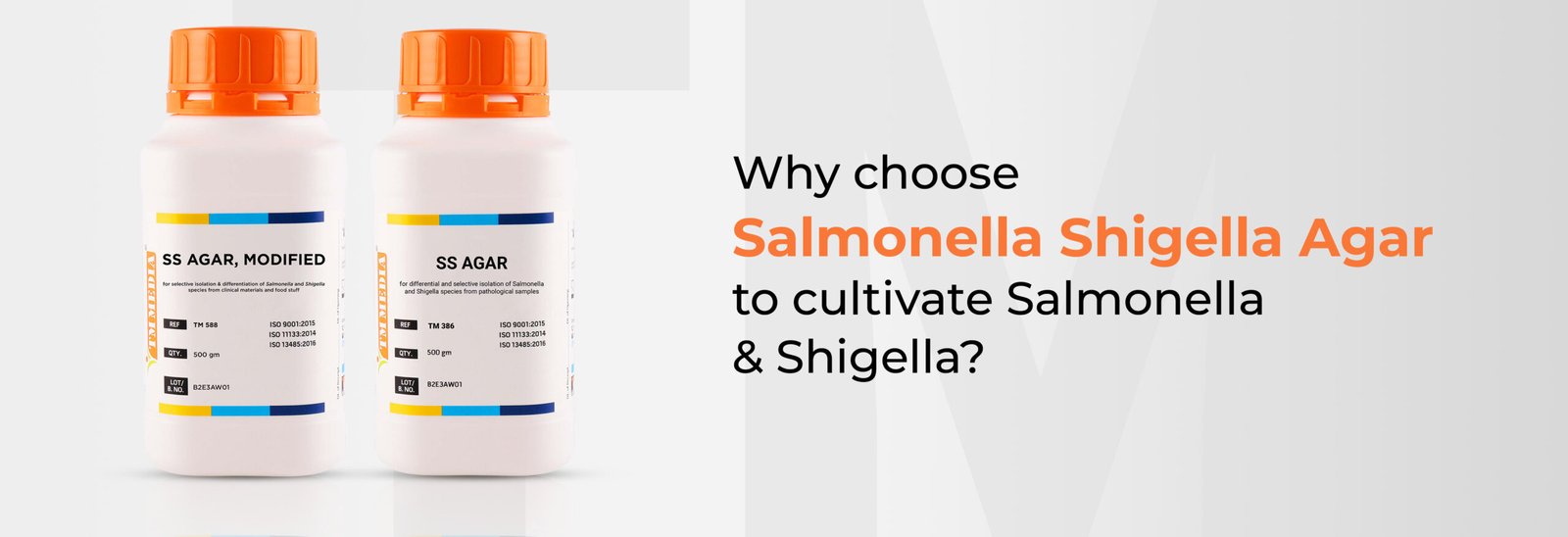
India officially has four seasons: winter, summer, monsoon, and post-monsoon and every season has its unique characteristics. And these unique...
Read More